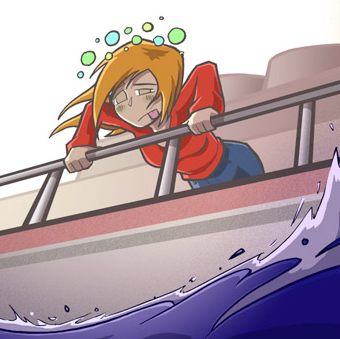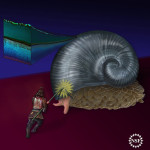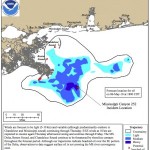
Whenever I give public talks, the number one question I get asked is “Do you ever get seasick?” People are usually surprised when the answer is “OMG YES.” I get seasick Dr. Seuss style – on a boat, on a float, here and there, everywhere. My family, who are all prone to barfage, think I am completely insane for subjecting myself to this voluntarily. (The Goldstein family whale watch of 1990 was NOT a success.)
But since going to sea is glorious and wonderful and totally worth the cookie-tossing, I’ve developed some methods to deal with it. And I will share them with you, beloved readers, for the low low cost of your love & admiration.
Seasickness Prevention
- Make your stomach as neutral as possible. Acidic substances will make seasickness very hard to control. I don’t drink either coffee or orange juice the day before going to sea, or while at sea (and I usually ADORE my morning cup). You’ll want to avoid spicy and heavy foods as well – put down that burrito!
- Stay on deck. The horizon and the fresh air are your best friends. Going to lie down below, or crouching over the toilet, will make everything worse. Also, I promise you, barfing into the ocean is far more pleasant than barfing in the tiny miserable head. With time, you will grow to enjoy barfing in the cool fresh air. Just remember that safety is paramount – make sure that you have a friend to grab the back of your PFD if you need to lean over the rail. This is REALLY REALLY important if you’re on a research vessel with relatively low rails & a fantail. Falling overboard while vomiting and then dying a slow slow death floating all alone in the ocean is NOT the way you want to go.
- Maintain a cheery mental state as much as possible. After barfing all over the world, I am convinced that about half of seasickness is psychological. Many people get sick, but for 95% of them it passes after a day or two. If you are miserably dreading getting sick and hating life once you get sick, it will be worse. If you accept that yes, you will feel sick for a while, but then you’ll be having an awesome time at sea, it won’t be as bad. Stare at the horizon, relax, and breath deeply. Look for birds and whales and mola-mola (without binoculars-binos make it worse). Enjoy being out at sea as much as you can.
Medications and Other Products
I am not a doctor. I am not even a doctor of oceanography (yet!). All of the below advice is my personal opinion, and you should not do anything without consulting your own Doctor of People Medicine.
- Ginger. Ginger (in pills or chewable tablets or in crystallized candy form) does help with mild nausea in my experience. It won’t help people who are really prone to sickness, but it will help borderline cases. Also it’s tasty and has no side effects, so what’s the harm? (Actually, the harm is that after barfing up lots of ginger, you’ll grow to hate ginger. Don’t ask me how I know.)
- Wristband Thingies. It’s my opinion that those elastic wristbands that apply pressure with little tablets are purely psychological. They’ve never worked for me. BUT – since half of seasickness is psychological – if you think they’ll work they very well might. Since they’re cheap and have no side effects other than weird marks on your wrists, give them a try.
- Over-the-counter drugs. These work for mild to moderate seasickness, but not for serious seasickness. They will all make you sleepy, and you should use caution while diving or operating a boat or machinery while taking them. It’s my opinion that Bonine is better than Dramamine, but frankly none of them do much for me and I haven’t used them in years.
- The scopolomine patch (Transderm-Scop). This is a little sticky patch, prescription only, that is applied behind the ear. I highly recommend it – in reasonable conditions I felt fine, and in nasty conditions I felt a little queasy but did not throw up. It does have noticeable side effects, mostly nasty dry mouth and weird dreams. You must also be very careful to not transfer any bits from the patch to your eyes. Each patch lasts for 3 days, but if you’re going to be out at sea for a shorter time, DO NOT cut the patch in half! This will sever the little mesh that delivers the medicine, and it will dump a whole bunch in your system at once, and you will be sorry. If you want to try the patch, use one for a couple days on land to see if you can stand the side effects.
- Scopolomine pills (Sco-Pace). This is the same active ingrediant as the patch, but in pill form. It is not usually stocked at pharmacies, but you can order it (with a Rx) from drugstore.com. In my opinion it is not as effective as the patch, but since each pill only lasts for 12 hours, it is more useful for day trips. It can also be good for smaller people for whom the patch delivers too much dosage. Unfortunately after years of intensive patch use I have developed a sensitivity to the adhesive, so the scopolomine pill is now my default barfage control method (along with no coffee & staring at the horizon in the fresh air).
- Promethazine. This is a super hard-core anti-nausea prescription medication. It works really, really well, but it will also knock you right out. I keep this for storms, when I just need to sleep through the sickness. But in my experience it’s not that useful if you have to work or if you want to actually be awake to fish or dive or have fun.
Add your own seasickness suggestions below! I am always really happy to hear about other people’s strategies.






I have a fool proof strategy that involves being behind a desk all day reading about research expeditions.
there 2 types of people:
-those who get seasick
-those who have yet to be seasick
as someone who shares your fatal confluence of occupation and predilection to hurl, i’d like to toss, er, i mean offer a remedy that seems to help me…
i’m a BIG fan of the scop patch which has gotten me through many trips to the farallone islands in conditions that resembled scenes from “victory at sea”…
even when the scop patch can’t hold back the nausea from high seas, i can usually fight back the vomiting by eating a few dry saltine crackers… while there are certainly some oils/fat used in the manufacture of most crackers (which can potentially throw an already queasy stomach into reverse peristalsis), i find that the mouth drying effect of the crackers can at least take my mind off the bile and saliva production that have kicked into overtime…
Make sure you are not on the top deck when you barf overboard while steaming to your study site… just sayin’
For me, its throw up once and good to go for the rest of the trip no matter the weather. Ginger ale and saltines do wonders too!
I second the saltine suggestion and would like to up the ante by adding Sprite to the mix (preferably fountain soda Sprite with ice). On the most topsy-turvy of ships (R/V New Horizon, I’m talking to you), this combo has helped me maintain some sort of equilibrium during the worst of times.
And as far as medicine goes, my personal favorite is Bonine (Meclizine HCl), taken up to 4 times a day (prescription-strength). This kicks the butt of dramamine (in my world, at least).
A few words of advice while on board: Avoid microscopes, ship fumes (don’t stand behind the smoke stacks), and upper decks (the higher you go, the queasier you get).
You’re in good company, Charlie D spent most of his voyage leaning over the side of the Beagle.
The only shame in being seasick is if you don’t make it into the ocean.
I like to refer to the outcome of sea-induced nausea as an oceanographic enrichment experiment. I am helping in carbon sequestration. If your not part of the solution…
Admittedly, I did my own research from a small vessel in the intertidal AND I don’t get easily seasick. On the other hand, I get REALLY sick watching people around me turn green… Leaving for a 8 day trip on a research vessel, I got a piece of advice from an experienced researcher who used to spend weeks in Faroese waters: when you start getting queasy, sit down and have a proper meal. Sounds like the last thing you would like to do, but it worked wonders the few times I’ve had to try it.
I also subscribe to the ‘fresh air’ and ‘horizon is your best friend’- mentioned above!
As a diver, I’ve found that sometimes the best relief is simply getting off the boat and into the water for a dive.
Being in the water is not the same as being on a boat. I generally feel relief very quickly. Use common-sense though, if a seriously bad case of sea sickness, then it may not be advisable.
And the last one…an add on to the “fresh air”….avoid exhaust fumes from the outboard motor at all costs.
Cheers all!
After getting stuck in too many storms at sea I have always got a stash of stugeron 15 tablets. Saved the contents of my stomach on several mooring deployment. Also ritz crackers help.. But once it has you looking green there is only one way to feel better. I’m just glad most of my measurements are made from automated stations. :-)
Fresh air and facing the direction of motion, or sideways to it, works best for me. If you feel the sickness starting to brew (dizziness, sweats etc) suck on a saltwater ice cube – makes me sick almost instantly. No sense in battling against it, so just get the stuff out. The after effects of a good vomit seems to bring on some weird kind of high – or is that just me?
Sorry Rick, I am in that third category — I just don’t get seasick. I usually dive the east end of grand cayman, which is notoriously rough. The worst thing that ever happened to me was that another diver yelled at me for calmly reading a magazine during a bouncy surface interval when everyone else was “feeding the fish.”
Hot topic, Miriam! I, too, have grown to hate ginger from being twice-acquainted with too much of it. I have to say I find the medical confusion around the actual mechanism of seasickness totally fascinating. (Although I strongly agree that much of it is psychological.) Eddie Izzard explained it as well as I’ve seen anywhere: “Throwing up is controlled by three little bones in the inner ear. They’re called Shadrach, Meshach and Abednego. And they control hearing and vomiting. Don’t know why they go together. God went, ‘Inner ear, you shall have hearing and vomiting as well. Yes, that’ll be fun.'”
P.S. I meant to link, for anyone feeling vomitiously nerdy or just bored, to my lengthy exploration of said medical confusion.
Those ginger pills/capsules work great…unless you vomit them overboard. Nothing like seeing the pills you took a few minutes ago come flying, whole and intact, back out projectile-style. It would actually be funny if it weren’t such a cosmic slap in the face
To this day, the smell of diesel fumes and burned coffee makes me nauseous. I always fell into the “do it once and get it over with” camp….
I am a fan of prevention, dramamine and ginger! All the best and I hope you will have a great and fun and not unpleasant time…
If there is a world record for puking, i’ve definitely won it. I’ve counted and puked 20+ times on a single.
Other random tips:
– Start taking your medication before you even get on the ship. I start 24 hrs prior.
– If you are career puker like myself, you get dehydrated really fast. I pack gatorade to help me stay hydrated. I also pack luna bars because I find I can keep them down and get some nutrition.
– Plain water is really hard on your stomach and might irritate an already empty stomach. Nibble some crackers before taking a giant swig or try something with a little sugar, like soda or gatorade.
– Bonine, Dramamine, and Meclizine use one metabolic pathway to fight nausea, scopalamine uses another and promethazine uses yet another. If one medication doesn’t work, maybe another will.
– Coast guard cocktail = prometazine +ephedrine = an upper + a downer. Some people swear by this.
Just eat plenty regularly and drink plenty; I like Bovril in hot water. 3 days in cyclone, 40’s south lat Helm lashed under bare poles, dehydration worst enemy one comotose just sweating. survived because the wind quieted a bit, no help out there.
Those of us not sick forced rest to drink and eat even if most came straight up again some fluid seemed to stick.3 days later under storm rig every became happy again or mostly .
Good timing, Miriam! I have just been informed by my tugboat captain that our normally 14 hr trip to Kauai is going to take 24, and to tie down anything heavy (or put it on the floor). Will be ingesting some pills shortly.
I generally have a very strong stomach, but at times (30 kt wind, trying to sleep in my cabin) it has been sorely tried. Here’s my 2 cents:
1) if you can’t be outside in the cool breeze, at least be cool. Snuggling up under warm blankets is NOT your friend.
2) breathe deeply- I have battled and beat many nauseous nights with deep breaths.
3) medicine is not the enemy, and it does not make you weak. I never took sea sickness meds until this year, but I wish I hadn’t been so macho. It’s better to sleep than to barf.
4) I agree about rich foods, and would also like to add hard to digest, but not rich foods (such as high-fiber vegetables). Eat stuff that your stomach won’t have to work to digest, and make it neutral (like crackers)!
I may have more tips after what I am sure will be a LOVELY Kauai channel crossing. Lovely… Blechhhh.
Erm, have fun? And report back!
Reporting back:
Took one Meclizine, no seasickness, slept like a log. The weather was pretty rough, too (pelican cases sliding to and fro throughout the night).
I don’t know about the rest of you, but Meclizine knocks me out for something like 36 hours. I took one last night at about 8:00. It’s now the next day, and I’m still drowsy. I tried taking half at a time on the last trip, and I was able to function like a normal (non-ragdoll) human the next day. Moral of the story: each person reacts differently.